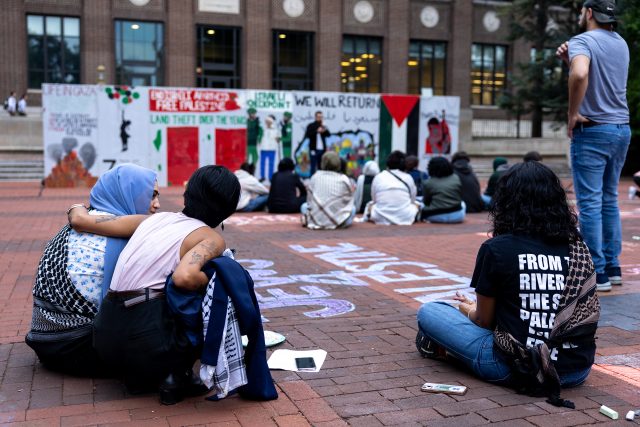[ad_1]
Nearly two decades after their first annual demonstration in 2003, members of Students Allied for Freedom and Equality at the University of Michigan once again brought attention to the history of Israeli violence against Palestinians by constructing a mock wall on the Diag designed to represent the barrier that separates Israel from Gaza and the West Bank.
The event included speeches from students, personal stories and information about the ongoing Israeli military campaign in Gaza. The event also featured a teach-in on the wall itself, which borders the West Bank for more than 700 kilometers and contains Israeli-run checkpoints. Israel has used these checkpoints and other obstacles to levy additional travel restrictions on Palestinians since Hamas’s Oct. 7 attack. The event’s mock wall, which featured artwork and statistics about Palestinian deaths, land loss and food insecurity, displayed messages like “We will return” painted across the barrier.
LSA senior Rawan Elhusseini, director of operations for SAFE, told The Michigan Daily in an interview that the demonstration aimed to bring attention to the broader context of violence against Palestinians that has persisted decades prior to the recent escalations.
“This wall is a representation of the apartheid wall that’s up in the West Bank, and we hold this event every year,” Elhusseini said. “We’ve been holding this for years, talking and showing people the atrocities happening in the West Bank. This isn’t something new to us. It didn’t start on Oct. 7.”
Rackham student Ira Anjali Anwar, a member of the TAHRIR Coalition — a group of more than 90 pro-Palestine organizations — and the co-chair of the Graduate Employees’ Organization’s Solidarity and Political Action Committee, explained the use of the word apartheid when describing the border wall in an interview with The Daily.
“It’s primarily an event for political education to bring awareness to the particular nature of the apartheid that has been going on in Palestine for over 75 years under Israeli occupation,” Anwar said. “While there are parallels with apartheid (in) South Africa, for instance, the way apartheid has functioned in Palestine is unique, because it’s not so much just about separating Israelis and Palestinians, but it’s about the fragmentation and isolation of Palestinians themselves.”
Several students stood alongside the wall holding informational cards. According to Anwar, this was an effort to both highlight details of the impact of Israeli occupation and to evoke the image of a human wall.
“I think it’s beautiful because there’s an attempt to try and illustrate as visually as possible to depict what it would be like to be in apartheid Palestine and Israeli occupation,” Anwar said.
In an interview with The Daily, LSA freshman Ayan Kamdar said she attended the event not only to support Palestine but also the people of Lebanon. In the last two weeks, Israeli forces have launched operations on the Hezbollah militant group throughout the country, killing more than 720 and wounding more than 1,835, according to Lebanon’s Health Ministry.
“When is this just gonna end?” Kamdar said. “It’s been a year almost, and now there’s new bombings in other countries like Lebanon and Syria. It’s just basic human nature that you don’t want people to get killed anymore.”
During the event, U-M alum Svetlana Toder, a parent of a current student and a former U-M employee, held an Israeli flag while standing next to the mock wall. In an interview with The Daily, Toder said she believed the event could make Jewish students feel unsafe, so she brought the flag as a show of support for them.
“Unfortunately, events like the one happening right now — while it seems innocent and it seems like they’re exercising their freedom of speech — they actually incite a lot of hate and violence for Jewish students,” Toder said. “The reason why I came today is because a lot of Jewish students expressed concerns about walking throughout campus and being identified as Jewish, and I came here … to show Jewish students and students that support Israel that they have somebody on their side.”
Social Work student Helen Shanker said she attended the event to express her solidarity with the Palestinian cause. Shanker, a Jewish student, said she hoped the mock apartheid wall would draw attention to the ongoing violence in Gaza.
“As a Jewish member of the community that is advocating for Palestine, I think it’s really important to show up, especially a year since Oct. 7, and many years into the genocide,” Shanker said. “I want to honor the stories and the art that represents the very real apartheid wall surrounding the West Bank. It occupies and imprisons many human beings without rights or access to ample food and water.”
Daily Staff Reporters Emma Spring and Marissa Corsi can be reached at sprinemm@umich.edu and macorsi@umich.edu.
Related articles
[ad_2]
Source link











